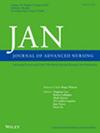基于机器学习的老年住院患者谵妄风险预测模型的开发和验证:一项前瞻性队列研究
IF 3.4
3区 医学
Q1 NURSING
引用次数: 0
摘要
目的建立并验证基于机器学习的老年住院患者谵妄风险预测模型。设计前瞻性队列研究。方法采用前瞻性队列研究。从住院期间的电子病历中前瞻性地收集18个临床特征,以告知模型。采用四种机器学习算法来开发和验证风险预测模型。在选择SHAP解释的最佳模型之前,所有模型在训练集和测试集中的表现都是通过结合受试者工作特征曲线下的面积(AUC)、准确性、灵敏度、Brier评分和其他指标来评估的。结果共使用973例老年住院患者数据进行模型构建和验证。4个机器学习模型在训练集和测试集上的AUC范围为0.869 ~ 0.992;准确度范围为0.931 ~ 0.962;灵敏度范围为0.564 ~ 0.997。与其他模型相比,随机森林模型的综合性能最好,AUC为0.908 (95% CI, 0.848, 0.968),准确度为0.935,灵敏度为0.992,Brier评分为0.053。结论我们开发并验证的机器学习模型预测老年住院患者谵妄具有良好的预测效果。该模型具有帮助医疗保健专业人员早期诊断和支持知情临床决策的潜力。通过早期识别谵妄风险的患者,医疗保健专业人员可以实施预防措施和及时干预,潜在地降低谵妄的发病率和严重程度。该模型支持知情临床决策的能力可以导致更个性化和有效的护理策略,最终使患者和医疗保健提供者受益。报告方法本研究按照TRIPOD声明进行报告。病人或公众捐款:没有病人或公众捐款。本文章由计算机程序翻译,如有差异,请以英文原文为准。
Development and Validation of a Machine Learning‐Based Risk Prediction Model for Delirium in Older Inpatients: A Prospective Cohort Study
AimsTo develop and validate a machine learning‐based risk prediction model for delirium in older inpatients.DesignA prospective cohort study.MethodsA prospective cohort study was conducted. Eighteen clinical features were prospectively collected from electronic medical records during hospitalisation to inform the model. Four machine learning algorithms were employed to develop and validate risk prediction models. The performance of all models in the training and test sets was evaluated using a combination of the area under the receiver operating characteristic curve (AUC), accuracy, sensitivity, Brier score, and other metrics before selecting the best model for SHAP interpretation.ResultsA total of 973 older inpatient data were utilised for model construction and validation. The AUC of four machine learning models in the training and test sets ranged from 0.869 to 0.992; the accuracy ranged from 0.931 to 0.962; and the sensitivity ranged from 0.564 to 0.997. Compared to other models, the Random Forest model exhibited the best overall performance with an AUC of 0.908 (95% CI, 0.848, 0.968), an accuracy of 0.935, a sensitivity of 0.992, and a Brier score of 0.053.ConclusionThe machine learning model we developed and validated for predicting delirium in older inpatients demonstrated excellent predictive performance. This model has the potential to assist healthcare professionals in early diagnosis and support informed clinical decision‐making.ImpactBy identifying patients at risk of delirium early, healthcare professionals can implement preventive measures and timely interventions, potentially reducing the incidence and severity of delirium. The model's ability to support informed clinical decision‐making can lead to more personalised and effective care strategies, ultimately benefiting both patients and healthcare providers.Reporting MethodThis study was reported in accordance with the TRIPOD statement.Patient or Public ContributionNo patient or public contribution.
求助全文
通过发布文献求助,成功后即可免费获取论文全文。
去求助
来源期刊
CiteScore
6.40
自引率
7.90%
发文量
369
审稿时长
3 months
期刊介绍:
The Journal of Advanced Nursing (JAN) contributes to the advancement of evidence-based nursing, midwifery and healthcare by disseminating high quality research and scholarship of contemporary relevance and with potential to advance knowledge for practice, education, management or policy.
All JAN papers are required to have a sound scientific, evidential, theoretical or philosophical base and to be critical, questioning and scholarly in approach. As an international journal, JAN promotes diversity of research and scholarship in terms of culture, paradigm and healthcare context. For JAN’s worldwide readership, authors are expected to make clear the wider international relevance of their work and to demonstrate sensitivity to cultural considerations and differences.

 求助内容:
求助内容: 应助结果提醒方式:
应助结果提醒方式:


